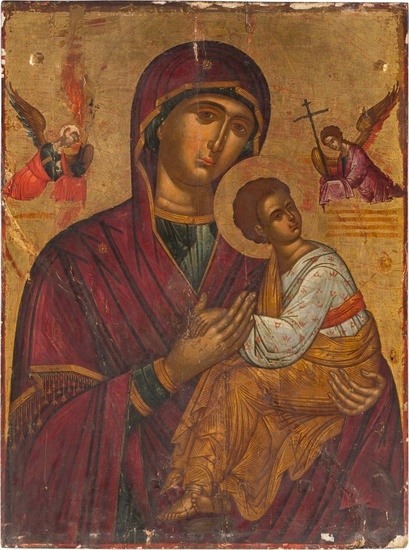ANDREAS RITZOS
ANDREAS RITZOS 1921 Candia/Crete - 1492 (Circle of) A VERY IMPORTANT AND MONUMENTAL ICON SHOWING THE MOTHER OF GOD OF THE PASSION FROM A CHURCH ICONOSTASIS Cretan, late 15th century Tempera on wood panel. The Mother of God portrayed half-length, looking at the beholder, supporting Christ on her left forearm, the latter leaning forward, turning his head towards the angel behind him and grasping his Mother's right hand. The two angels carrying the instruments of Christ's Passion. The garments of the Mother of God coloured in complimentary deep red and blue, the stars on her forehead and the edges of her maphorion rendered in gold, Christ's white chiton decorated with lilies, his orange himation highlighted with dense chrysography. Against a gold background. The long inscription at right means: He who previously declared ''hail!'' to the All-Pure One now shows the symbols of the Passion, and Christ, clothed in mortal flesh, timorously fears on seeing them. Wearings, minor losses to the borders, minimally restored. Traces of a signature at the base of the icon. 85 x 64 cm. This iconography of the Mother of God was developed in Crete during the 15th century. One of the most famous, early examples of the subject is the icon painted by the celebrated Cretan iconographer, Andreas Ritzos, today at the Recklinghausen Museum. This icon bears stylistic similarities to Ritzos's icon as seen in the colours, the geometrical rendition of the folds and the fine, white highlights on the flesh. For similar icons see: I. Bentchev - E. Haustein-Bartsch: Muttergottesikonen, Recklinghausen 2000, Kat. 85. M. Vassilaki: The Hand of Angelos, Athen 2010, Fig 28._x0013_ANDREAS RITZOS 1421 Candia/Kreta - 1492 (Umkreis) MUSEALE UND MONUMENTALE IKONE MIT DER GOTTESMUTTER DER PASSION AUS EINER KIRCHEN-IKONOSTASE Kreta, Ende 15. Jh. Verbund dreier Bretter mit zwei aufgenagelten Rückseiten-Sponki (verloren). Eitempera auf Kreidegrund über Leinwand, Vergoldung. 85 x 64 cm. Reste einer Signatur am unteren Rand. Die vierzeilige Inschrift (Tetrachstichon) rechts von dem Christusknaben ist die typische Erklärung, die sich sowohl in griechischer als auch in lateinischer Sprache bei der Darstellung - je nach Auftraggeber - finden lässt: Bevor er [Erzengel Gabriel] der ganz Reinen den Gruß entbot, zeigt er die Leidenswerkzeuge, Christus aber, sterbliches Fleisch geworden, sieht sie furchtsam in Todesangst. Diese Beischrift lässt sich ebenfalls auf einer Ikone mit der Gottesmutter der Passion finden, die sich heute im Ikonenmuseum in Recklinghausen befindet und Andreas Ritzos zugeschrieben wird. Eine dreiteilige Ikone in Bari mit dem heiligen Nikolaus von Myra, der Gottesmutter der Passion und Johannes, dem Theologem im Schweigen, die ebenfalls Andreas Ritzos zugeschrieben wird, legt aufgrund der engen stilistischen Nähe eine Zuschreibung dieser Ikone an den Künstler oder zumindest in seinen näheren Umkreis nahe. Bereibungen, kleinere Substanzverluste im Randbereich, min. rest. Literatur: I. Bentchev - E. Haustein-Bartsch: Muttergottesikonen, Recklinghausen 2000, Kat. 85. M. Vassilaki: The Hand of Angelos, Athen 2010, Fig 28.
[ translate ]Sale price
Estimate
Time, Location
Auction House
ANDREAS RITZOS 1921 Candia/Crete - 1492 (Circle of) A VERY IMPORTANT AND MONUMENTAL ICON SHOWING THE MOTHER OF GOD OF THE PASSION FROM A CHURCH ICONOSTASIS Cretan, late 15th century Tempera on wood panel. The Mother of God portrayed half-length, looking at the beholder, supporting Christ on her left forearm, the latter leaning forward, turning his head towards the angel behind him and grasping his Mother's right hand. The two angels carrying the instruments of Christ's Passion. The garments of the Mother of God coloured in complimentary deep red and blue, the stars on her forehead and the edges of her maphorion rendered in gold, Christ's white chiton decorated with lilies, his orange himation highlighted with dense chrysography. Against a gold background. The long inscription at right means: He who previously declared ''hail!'' to the All-Pure One now shows the symbols of the Passion, and Christ, clothed in mortal flesh, timorously fears on seeing them. Wearings, minor losses to the borders, minimally restored. Traces of a signature at the base of the icon. 85 x 64 cm. This iconography of the Mother of God was developed in Crete during the 15th century. One of the most famous, early examples of the subject is the icon painted by the celebrated Cretan iconographer, Andreas Ritzos, today at the Recklinghausen Museum. This icon bears stylistic similarities to Ritzos's icon as seen in the colours, the geometrical rendition of the folds and the fine, white highlights on the flesh. For similar icons see: I. Bentchev - E. Haustein-Bartsch: Muttergottesikonen, Recklinghausen 2000, Kat. 85. M. Vassilaki: The Hand of Angelos, Athen 2010, Fig 28._x0013_ANDREAS RITZOS 1421 Candia/Kreta - 1492 (Umkreis) MUSEALE UND MONUMENTALE IKONE MIT DER GOTTESMUTTER DER PASSION AUS EINER KIRCHEN-IKONOSTASE Kreta, Ende 15. Jh. Verbund dreier Bretter mit zwei aufgenagelten Rückseiten-Sponki (verloren). Eitempera auf Kreidegrund über Leinwand, Vergoldung. 85 x 64 cm. Reste einer Signatur am unteren Rand. Die vierzeilige Inschrift (Tetrachstichon) rechts von dem Christusknaben ist die typische Erklärung, die sich sowohl in griechischer als auch in lateinischer Sprache bei der Darstellung - je nach Auftraggeber - finden lässt: Bevor er [Erzengel Gabriel] der ganz Reinen den Gruß entbot, zeigt er die Leidenswerkzeuge, Christus aber, sterbliches Fleisch geworden, sieht sie furchtsam in Todesangst. Diese Beischrift lässt sich ebenfalls auf einer Ikone mit der Gottesmutter der Passion finden, die sich heute im Ikonenmuseum in Recklinghausen befindet und Andreas Ritzos zugeschrieben wird. Eine dreiteilige Ikone in Bari mit dem heiligen Nikolaus von Myra, der Gottesmutter der Passion und Johannes, dem Theologem im Schweigen, die ebenfalls Andreas Ritzos zugeschrieben wird, legt aufgrund der engen stilistischen Nähe eine Zuschreibung dieser Ikone an den Künstler oder zumindest in seinen näheren Umkreis nahe. Bereibungen, kleinere Substanzverluste im Randbereich, min. rest. Literatur: I. Bentchev - E. Haustein-Bartsch: Muttergottesikonen, Recklinghausen 2000, Kat. 85. M. Vassilaki: The Hand of Angelos, Athen 2010, Fig 28.
[ translate ]


